For the first time in almost a millennium the Bayeux Tapestry is set to leave Normandy for a major show in London: the British Museum will host the 70‑metre embroidered narrative of the 1066 Norman invasion in its Sainsbury Exhibitions Gallery from September 2026 until July 2027, under a loan agreed at the highest levels of government. According to a British Museum press release and a UK government statement, the agreement followed discussions between Prime Minister Keir Starmer and French President Emmanuel Macron and is presented as a cultural exchange intended to strengthen cross‑Channel ties.
Historians and curators describe the loan as a symbolic “homecoming.” The Bayeux Museum and scholarly accounts note that the tapestry was probably worked in an English workshop in the later 11th century and is commonly linked to Bishop Odo of Bayeux, who is thought to have commissioned the embroidery for the cathedral’s dedication around 1077. That provenance helps explain why the cloth has an unusually powerful hold on Britain’s historical imagination: the events it depicts — culminating in William of Normandy’s victory at Hastings — are often presented as the defining moment of English medieval history. As Antoine Verney, curator of the Bayeux Museum, told The Associated Press, “For the British, the date — the only date — that all of them know is 1066.”
The tapestry itself is extraordinary in scale and detail. Composed of nine joined pieces of linen and stitched in coloured wool, it runs roughly 70 metres and unfolds in 58 scenes populated by some 626 human figures, 202 horses and many ships, buildings and captions. Its embroidered panels narrate events from 1064 through the Battle of Hastings in 1066 and include the famous image of King Harold bearing the fatal wound said to the eye. Museums and reference works underline both its artistic achievement and its value as a contemporaneous source for the Norman Conquest.
Officials say the loan comes with careful reciprocal arrangements and shared conservation planning. The British Museum has highlighted that the exhibition will be accompanied by reciprocal loans — notably objects from the Sutton Hoo ship burial and the Lewis chessmen — and that conservation teams in London and Bayeux will work together on technical studies and handling protocols. The UK government’s statement dated 8 July 2025 frames the exchange as cultural diplomacy, while the British Museum has emphasised collaborative conservation as central to the project.
Transporting a garment of such age and fragility poses significant technical and ethical questions. Conservators and the Bayeux curator have repeatedly warned that nine centuries of exposure have left the linen fibres degraded and that any movement carries risk. “There is always a risk. The goal is for those risks to be as carefully calculated as possible,” Verney told The Associated Press, and he said bilateral studies are under way to define safeguards and logistics. The British Museum, in its announcement, stressed that those technical and conservation studies are being carried out in partnership with Bayeux authorities to reduce any chance of damage.
The loan has also been timed to allow a major reinvention of the Bayeux museum itself. The Bayeux authorities have announced a closure of the existing museum from 1 September 2025 to permit a multi‑million‑euro redevelopment, led by architects RSHP, that will reopen in October 2027 with the tapestry mounted on an inclined, hermetically sealed support designed to protect the cloth from light, humidity and pollution while improving viewing. The Bayeux site reported more than 423,000 visitors in 2023 and says the embroidery has attracted some 15 million viewers since the museum’s modern opening in 1983, underscoring the wide public interest that underpins the decision to lend it.
The loan also follows the tapestry’s selective earlier travels: it was displayed in Paris under Napoleon in 1803–04 and was again taken to the Louvre after the liberation of Paris in 1944. Those past movements, historians note, were exceptional and surrounded by political significance; today’s arrangement has been framed by both governments as a carefully negotiated cultural gesture between neighbours whose relationship has been strained and reworked in the post‑Brexit era.
Despite the fanfare, curators and officials stress that the tapestry’s return to Bayeux after the British exhibition is part of the plan. The Bayeux Museum says the embroidery will be returned to France in order to undergo extensive conservation and to be re‑housed in the new building; the British Museum and UK ministers have emphasised that every precaution will be taken to ensure its safety while on display in London. For now, the prospect of millions more visitors seeing the cloth outside Normandy stimulates excitement among curators and the public — but it also focuses attention on the practical challenges of moving and caring for a textile that is at once a masterpiece of medieval storytelling and a nearly thousand‑year‑old artefact.
📌 Reference Map:
##Reference Map:
- Paragraph 1 – [2], [3], [1]
- Paragraph 2 – [4], [1], [7]
- Paragraph 3 – [4], [2], [6], [7]
- Paragraph 4 – [2], [3]
- Paragraph 5 – [1], [6], [2], [3]
- Paragraph 6 – [5], [2], [1]
- Paragraph 7 – [1], [7]
- Paragraph 8 – [2], [5], [3]
Source: Noah Wire Services
